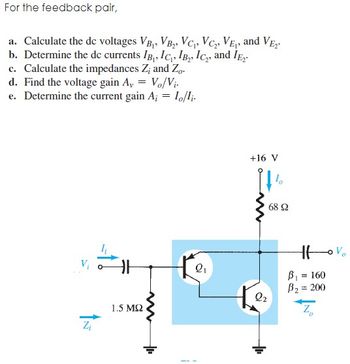For the feedback pair, a. Calculate the dc voltages VB₁, VB₂, VC₁, VC₂, VE₁, and VE₂ b. Determine the dc currents IB, IC₁, IB₂ IC₂, and IE₂. c. Calculate the impedances Z; and Zo. d. Find the voltage gain A, = Vo/Vi. e. Determine the current gain A; = 10/1j. V₁ Z HH 1.5 ΜΩ + Q₁ +16 V 68 92 Q2 t Ht ov B₁ = 160 B₂ = 200 Z
For the feedback pair, a. Calculate the dc voltages VB₁, VB₂, VC₁, VC₂, VE₁, and VE₂ b. Determine the dc currents IB, IC₁, IB₂ IC₂, and IE₂. c. Calculate the impedances Z; and Zo. d. Find the voltage gain A, = Vo/Vi. e. Determine the current gain A; = 10/1j. V₁ Z HH 1.5 ΜΩ + Q₁ +16 V 68 92 Q2 t Ht ov B₁ = 160 B₂ = 200 Z
Introductory Circuit Analysis (13th Edition)
13th Edition
ISBN:9780133923605
Author:Robert L. Boylestad
Publisher:Robert L. Boylestad
Chapter1: Introduction
Section: Chapter Questions
Problem 1P: Visit your local library (at school or home) and describe the extent to which it provides literature...
Related questions
Question

Transcribed Image Text:For the feedback pair,
a. Calculate the dc voltages VB₁, VB₂, VC₁, VC₂, VE₁, and VE₂
b. Determine the dc currents IB, IC₁, IB₂, IC₂, and IE₂.
c. Calculate the impedances Z; and Zo.
d. Find the voltage gain A, = Vo/Vi.
e. Determine the current gain A; = 1o/Ii.
Zi
#4
HH
1.5 ΜΩ
Q₁
+16 V
11%
Q2
68 Ω
Ht-ov
B₁ = 160
B₂ = 200
Z
Expert Solution
This question has been solved!
Explore an expertly crafted, step-by-step solution for a thorough understanding of key concepts.
Step by step
Solved in 4 steps with 1 images

Follow-up Questions
Read through expert solutions to related follow-up questions below.
Follow-up Question
current gain and voltage gain

Transcribed Image Text:For the feedback pair,
a. Calculate the dc voltages VB₁, VB₂, VC₁, VC₂, VE₁, and VE₂.
b. Determine the dc currents IB₁, Ic, IB₂, IC₂, and IE₂
c. Calculate the impedances Z; and Zo
d. Find the voltage gain A, Vo/Vi.
e. Determine the current gain A; = Io/Ii.
V₁
Z₁
HH
1.5 ΜΩ
m
2₁
+16 V
www
Q₂
68 92
HH
B₁ = 160
B₂ = 200
Z
Solution
Follow-up Question
find also the
a.Current Gain
b. Voltage Gain.
Solution
Knowledge Booster
Learn more about
Need a deep-dive on the concept behind this application? Look no further. Learn more about this topic, electrical-engineering and related others by exploring similar questions and additional content below.Recommended textbooks for you

Introductory Circuit Analysis (13th Edition)
Electrical Engineering
ISBN:
9780133923605
Author:
Robert L. Boylestad
Publisher:
PEARSON

Delmar's Standard Textbook Of Electricity
Electrical Engineering
ISBN:
9781337900348
Author:
Stephen L. Herman
Publisher:
Cengage Learning

Programmable Logic Controllers
Electrical Engineering
ISBN:
9780073373843
Author:
Frank D. Petruzella
Publisher:
McGraw-Hill Education

Introductory Circuit Analysis (13th Edition)
Electrical Engineering
ISBN:
9780133923605
Author:
Robert L. Boylestad
Publisher:
PEARSON

Delmar's Standard Textbook Of Electricity
Electrical Engineering
ISBN:
9781337900348
Author:
Stephen L. Herman
Publisher:
Cengage Learning

Programmable Logic Controllers
Electrical Engineering
ISBN:
9780073373843
Author:
Frank D. Petruzella
Publisher:
McGraw-Hill Education

Fundamentals of Electric Circuits
Electrical Engineering
ISBN:
9780078028229
Author:
Charles K Alexander, Matthew Sadiku
Publisher:
McGraw-Hill Education

Electric Circuits. (11th Edition)
Electrical Engineering
ISBN:
9780134746968
Author:
James W. Nilsson, Susan Riedel
Publisher:
PEARSON

Engineering Electromagnetics
Electrical Engineering
ISBN:
9780078028151
Author:
Hayt, William H. (william Hart), Jr, BUCK, John A.
Publisher:
Mcgraw-hill Education,